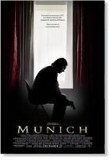|
Time Article: The Myths and Reality of Munich
After the slaughter of its Olympians, Israel vowed to hunt down the killers. But, says a new book, that's not whom it got.
Golda Meir didn't want to believe the news. The Israeli Prime Minister had heard media reports that West German police had rescued the Israeli Olympic athletes taken hostage by terrorists in Munich. Now Zvi Zamir, head of the Mossad, was phoning from Germany at 3 a.m. to correct that account. "I saw it with my own eyes," he told her. "No one was left alive."
That was the end of a debacle that had begun 23 hours earlier, when Palestinian terrorists from the Black September organization burst into the dorm housing the Israeli delegation at the 1972 Olympics and took 11 of its members hostage. It was also the start of a much longer, more complicated chapter in the saga: Israel's methodical extraction of revenge. About the events in Munich on Sept. 5, 1972, there is considerable clarity. The story of the reprisal missions, on the other hand, has been befogged by mystery.
The notion persists that the Israelis drew up a list of those responsible for Munich, then, one by one, knocked them off. But that's largely a myth, according to an upcoming book by TIME reporter Aaron J. Klein, Striking Back: The 1972 Munich Olympics Massacre and Israel's Deadly Response (Random House; 272 pages). The Israelis, Klein writes, had to settle for smaller targets, killing activists who for the most part had nothing to do with the Munich massacre and leaving alive, to this day, some who were involved.
The Munich spectacular was designed to be just that. Black September was an unacknowledged offshoot of Fatah, Yasser Arafat's faction within the Palestine Liberation Organization (P.L.O.). Abu Iyad, the Arafat deputy who headed Black September, later explained that the hostage taking was meant "to use the unprecedented number of media outlets in one city to display the Palestinian struggle--for better or worse!"
Security was lax at the Olympic Village. Wearing sweat suits, eight men simply climbed over a 6-ft. barrier around the village at 4:10 a.m. Armed with AK-47s, they rounded up 11 Israeli athletes, coaches and a referee, shooting two dead early on. The terrorists demanded the release of 234 prisoners from Israeli jails. Negotiations were ruled out by the Israelis, but the Germans began fake ones to buy time. In the afternoon, the Black September commander, distinctive in his white hat, insisted that his team and the hostages be flown to Cairo.
The Germans choppered them to Fürstenfeldbruck military airfield. When Issa, as the Black September commander called himself, and a comrade inspected the Boeing 727 they were promised, they found it empty and cold. As they raced back to the two helicopters, German snipers on the roof of a nearby building opened fire. The Palestinians shot out the lights on the tarmac, and the Germans were paralyzed for nearly an hour, until four armored police vehicles arrived. That prompted a terrorist to toss a grenade into one helicopter, and another to shoot the hostages in the other helicopter. Three Black September operatives survived; Germany freed them nearly two months later for the release of passengers on a hijacked Lufthansa jet.
Vowing to hunt down the perpetrators of Munich, Prime Minister Meir set up a process by which the head of the Mossad, Israel's spy agency, could make the case for a candidate's assassination. The PM and select Cabinet members would say yea or nay. If yea, the hit would be executed by a unit called Caesarea, dubbed by some media the Wrath of God team.
The first Palestinian to die was Wael Zwaiter, shot in Rome six weeks after Munich. Mossad told Meir he was head of Black September in Rome and had abetted the Munich massacre. But Klein, who based his book in large part on rare interviews with key Mossad officers involved in the reprisal missions, writes that the intelligence on Zwaiter was "uncorroborated and improperly cross-referenced. Looking back, his assassination was a mistake."
The Israelis, of course, wanted to get to the real planners and executors of Munich, but these had hunkered down with bodyguards in East-bloc and Arab countries, where the Israelis couldn't reach them. Meanwhile, lesser Palestinian activists wandered around West Europe unprotected, and so Palestinians began to die at the hands of assassins across Europe. Israeli security officials claimed these dead men were responsible for Munich; P.L.O. pronouncements made them out to be important figures; and so the image of the Mossad as capable of delivering death at will grew and grew.
The idea behind the slayings was not just to punish the perpetrators of Munich but also to disrupt and deter future terrorist acts. For the second goal, one dead P.L.O. operative was as good as another. Klein quotes a senior intelligence source: "Our blood was boiling. When there was information implicating someone, we didn't inspect it with a magnifying glass."
And Munich's actual perpetrators? Klein believes the Mossad got only one man directly connected to the massacre: Atef Bseiso, shot in Paris as late as 1992. Abu Iyad, Black September's chief, was killed by a fellow Palestinian in 1991. Abu Daoud, who commanded the Munich attack, was, ironically, allowed to enter Israel in 1996 so he could go to the Gaza Strip for a P.L.O. meeting convened to rescind an article in its charter calling for Israel's eradication. Of the three terrorists who survived the airfield firefight, one died of heart failure in the '70s. Another, Jamal al Gashey, appeared in the 2000 documentary One Day in September. Last summer P.L.O. veteran Tawfiq Tirawi told Klein that the third, his friend Mohammed Safady, was "as alive as you are."
By Lisa Beyer, Time Magazine
|
 |